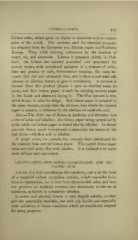Page 453 - My FlipBook
P. 453
LITMUS—LACMUS. 45I
Lichen order, which grow on Alpine or maritime rocks in various
parts of the world. The varieties used for chemical purposes
are obtained from the European and African coasts and Northern
Europe. They yield coloring substances by the reaction of
water, air, and ammonia. Litmus is prepared chiefly in Hol-
land ; the lichens are coarsely powdered and macerated for
several weeks, with occasional agitation in a mixture of urine,
lime and potassa or soda, fermentation ensuing; the mass be-
comes first red and ultimately blue, and is then mixed with cal-
careous or siliceous matter, to give it consistence. A tincture is
formed from this product (litmus i part to distilled water 20
parts), and blue litmus paper is made by steeping unsized paper
in the liquid and afterward drying it. The blue tincture is ren-
dered deeper in color by indigo. Red litmus paper is prepared in
the same manner, except that the tincture, into which the unsized
paper is steeped, is reddened by the addition of sulphuric acid.
Dose.—The chief use of litmus in medicine and dentistry is as
a test of acids and alkalies ; blue litmus paper being turned red by
acids, while red litmus paper is turned blue by alkalies. In dental
practice litmus paper is employed to determine the nature of the
oral fluids—whether acid or alkaline.
A single color, viz., purple, has recently been substituted for
the ordinary blue and red litmus paper. This purple litmus paper
turns red with acids, blue with alkalies. It is claimed to be much
more delicate and convenient.
LORETIN—META-IODO-ORTHO-OXYQUINOLINE AND SUL-
PHONIC ACID.
Loretin is a new succedanum for iodoform, and is in the form
of a beautiful yellow crystalline powder, which resembles iodo-
form in appearance, but is free from objectionable odor, and does
not produce an artificial eczema, two drawbacks to the use of
iodoform, as loretin is completely odorless.
In water and alcohol, loretin is only slightly soluble, in ether
and oils practically insoluble, but with oily liquids and especially
with collodion, it forms emulsions which are excellently adapted
for many purposes.


